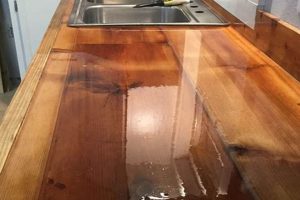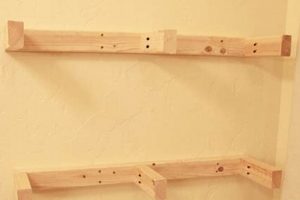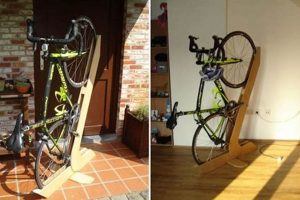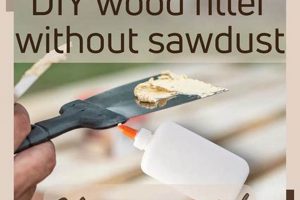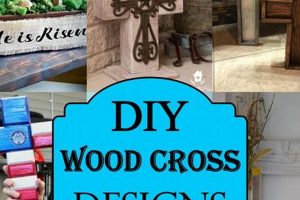A self-assembled storage solution for footwear, typically constructed from lumber, represents a practical approach to household organization. These constructions allow for the custom tailoring of dimensions and design to suit individual needs and available space. For instance, a narrow entryway might benefit from a vertically oriented structure, while a larger closet could accommodate a wider, multi-tiered arrangement.
The advantages of creating personal footwear storage are numerous, including cost savings compared to purchasing pre-fabricated units, the satisfaction derived from a hands-on project, and the ability to utilize reclaimed or repurposed materials. Historically, individuals have fashioned storage solutions from readily available resources, reflecting a resourceful approach to domestic necessities. This continues to be a popular method for both its economic and environmental benefits.
The following sections will explore material selection considerations, provide step-by-step construction guidance, and offer design ideas for crafting individualized storage spaces for footwear. Considerations include the appropriate type of wood, joinery techniques, finishing options, and customization strategies for diverse spaces and stylistic preferences.
Construction Recommendations
The following recommendations aim to enhance the durability, functionality, and aesthetic appeal of self-assembled footwear storage structures.
Tip 1: Material Selection is Paramount: Prioritize hardwoods such as oak or maple for components bearing significant weight. Softwoods like pine are acceptable for less critical elements, provided proper reinforcement is applied.
Tip 2: Accurate Measurements Ensure Stability: Precise dimensioning of all components is essential for a structurally sound framework. Discrepancies in measurements can lead to instability and reduced load-bearing capacity.
Tip 3: Employ Robust Joinery Techniques: Utilize joinery methods appropriate for the selected materials and load requirements. Dovetail, mortise-and-tenon, or pocket-hole joints offer superior strength compared to simple butt joints.
Tip 4: Pre-Drilling Prevents Splitting: When using screws or nails, pre-drill pilot holes, especially when working with hardwoods, to minimize the risk of splitting the wood fibers.
Tip 5: Apply a Protective Finish: Select a durable finish, such as polyurethane or varnish, to protect the wood surface from moisture, scratches, and wear. Multiple coats are recommended for enhanced protection.
Tip 6: Consider Ventilation: Incorporate ventilation into the design to prevent moisture buildup and odors. This can be achieved through strategically placed gaps or the use of breathable materials.
Tip 7: Reinforce High-Stress Areas: Identify areas subject to high stress or weight concentration, and reinforce them with additional support structures or thicker material.
Adhering to these recommendations will contribute to the creation of a long-lasting, functional, and aesthetically pleasing storage structure. Careful planning and execution are crucial for achieving optimal results.
The subsequent section will address common challenges encountered during the construction process and provide troubleshooting strategies.
1. Material Durability
Material durability is a fundamental consideration in the creation of a self-assembled footwear storage structure using lumber. The longevity and stability of the resulting object are directly correlated with the properties of the chosen wood and any associated materials.
- Wood Species Selection
The inherent characteristics of different wood species dictate their suitability for weight-bearing and environmental resistance. Hardwoods, such as oak or maple, offer superior strength and density, making them appropriate for structural components. Softwoods, like pine or fir, are less resistant to impact and moisture. Selection must align with anticipated load and humidity conditions. For example, a unit intended to hold heavy boots in a damp environment necessitates a rot-resistant, dense wood.
- Joint Integrity and Stress Resistance
The type of joints used significantly influences the overall structural integrity. Weak joints compromise the ability to withstand repeated use and applied weight. Durable joinery methods, such as mortise and tenon or dovetail joints, distribute stress more evenly across the structure. An inadequately joined structure may experience component failure, leading to collapse or instability under normal loading conditions.
- Finishing and Protection Against Degradation
Surface treatments play a vital role in safeguarding the wood from environmental factors that contribute to degradation. Moisture, ultraviolet radiation, and abrasive forces can degrade wood over time. The application of protective coatings, such as polyurethane or varnish, forms a barrier against these elements. Periodic reapplication of finish may be necessary to maintain optimal protection.
- Fastener Selection and Corrosion Resistance
The choice of fasteners (screws, nails, bolts) affects the long-term stability of the assembly. Inferior fasteners are prone to corrosion or failure under stress, potentially leading to structural weakness. Stainless steel or coated fasteners offer enhanced corrosion resistance, particularly in humid environments. Pre-drilling pilot holes is crucial to prevent wood splitting during fastener installation, further enhancing joint integrity.
Ultimately, the careful selection and preparation of durable materials, coupled with sound construction techniques, are essential for ensuring the longevity and functionality of a wooden footwear organizer. This extends beyond merely selecting wood; it involves a holistic approach to material properties and their interaction with the intended use environment.
2. Structural Integrity
Structural integrity, pertaining to a self-assembled wooden footwear storage unit, is the ability of the construction to maintain its shape and load-bearing capacity under anticipated stress. The primary cause of structural failure is inadequate design or flawed execution during construction. This can manifest as bowing shelves, wobbly frames, or complete collapse, rendering the unit unusable and potentially hazardous. The importance of structural soundness is paramount; a well-designed and constructed rack provides a stable and reliable platform for storing footwear, preventing damage and ensuring user safety. As an example, consider a design with long, unsupported shelves crafted from thin softwood. Over time, the weight of multiple pairs of shoes will cause the shelves to sag, compromising the rack’s intended function.
The selection of appropriate materials and joinery techniques directly influences structural performance. Hardwoods, possessing higher density and strength, are better suited for load-bearing elements than softwoods. Proper joinery, such as mortise and tenon or dovetail joints, distributes stress more effectively than simple butt joints, preventing localized failure. Reinforcing corners with gussets or brackets further enhances stability, particularly in larger units. Practical application of this understanding translates into selecting thicker lumber, employing stronger jointing methods, and strategically adding support elements to critical areas.
In conclusion, structural integrity is not merely a desirable attribute of a self-assembled footwear storage solution, but a fundamental requirement. Neglecting this aspect leads to a compromised structure susceptible to premature failure. The prudent selection of materials, application of sound engineering principles, and diligent execution are essential to ensuring a safe, functional, and durable storage unit. Future designs should prioritize structural analysis and consider load distribution to optimize performance and longevity.
3. Space Optimization
The construction of a footwear storage structure is frequently motivated by the need to maximize space efficiency within a given area. The inherent customizability associated with self-assembled wooden units allows for designs tailored to specific spatial constraints and storage requirements. In residences with limited square footage, such as apartments or small houses, optimizing storage solutions is particularly crucial. Pre-fabricated storage units often fail to adequately address these unique dimensional challenges, leading to inefficient space utilization and potential obstruction. The design and implementation of a custom-built wooden footwear organizer offers an alternative to address these deficits directly.
The application of strategic design principles further enhances space optimization. Vertical stacking, for instance, enables the effective use of vertical space, accommodating multiple pairs of footwear without occupying excessive floor area. Adjustable shelving allows for adaptation to varying footwear heights, maximizing storage density. Furthermore, the integration of storage structures into otherwise unused spaces, such as beneath staircases or within alcoves, represents a significant advantage of custom constructions. An example of effective space utilization is the creation of a narrow, multi-tiered structure that fits within an entryway closet, thereby freeing up floor space and improving accessibility. Another approach could involve building a unit that spans the length of a bedroom wall and provides both shoe storage and display space.
Effective space optimization when creating a footwear storage piece is crucial for creating efficient storage capabilities. By carefully assessing available space and adapting design strategies, creating space where no space exists. A successful design integrates seamlessly into the intended environment while simultaneously maximizing storage capacity, thereby contributing to a more organized and functional living space. Future development in space optimization techniques will lead to an even more productive capacity when building DIY shoe racks with wooden pallets.
4. Design Aesthetics
Design aesthetics, in the context of self-assembled wooden footwear storage, encompasses the visual properties and stylistic choices that determine the overall appearance and perceived appeal of the finished structure. This aspect extends beyond mere functionality, incorporating elements of proportion, form, color, and texture to create a cohesive and visually pleasing object.
- Wood Selection and Grain Orientation
The inherent characteristics of the chosen wood species, including color, grain pattern, and texture, significantly impact the aesthetic outcome. Species such as cherry or walnut offer richer tones and more pronounced grain patterns compared to lighter woods like pine. Furthermore, the orientation of the grain during construction can create visual interest or emphasize specific design features. An intentional alignment of the grain pattern can contribute to a more harmonious and aesthetically satisfying appearance. For example, continuous grain patterns across multiple shelves create a unified look.
- Form and Proportion
The overall shape and dimensions of the footwear storage unit are crucial to its aesthetic integration within the surrounding environment. Proportional relationships between height, width, and depth determine the visual balance of the structure. Streamlined, minimalist designs may be favored in contemporary settings, while more ornate or rustic forms align with traditional aesthetics. The selection of appropriate dimensions ensures that the unit complements the scale of the space and existing furnishings. A disproportionately large structure can overwhelm a small room, while an undersized unit may appear insignificant.
- Finishing Techniques and Color Palette
The application of stains, paints, or clear finishes alters the color and surface texture of the wood, influencing the perceived style and character of the piece. A natural finish emphasizes the inherent beauty of the wood grain, while colored stains allow for customization to match existing decor. Paint offers greater opacity and allows for a wider range of color options. The choice of finish also affects the level of protection against moisture and wear. A high-gloss finish creates a sleek, modern appearance, while a matte finish provides a more understated, rustic aesthetic. Selecting a unified color palette throughout the home can result in an especially professional look.
- Hardware and Decorative Elements
The addition of hardware, such as knobs, pulls, or decorative trim, provides opportunities to enhance the aesthetic appeal and functionality of the storage unit. The style and finish of hardware should complement the overall design aesthetic. Simple, minimalist hardware aligns with contemporary designs, while ornate hardware may be more appropriate for traditional styles. Decorative trim can add visual interest and texture to the structure. These elements contribute to the perceived quality and attention to detail of the finished piece. The use of ornate hardware adds an element of beauty that is hard to discount.
The strategic consideration of these aesthetic elements contributes to the creation of a self-assembled footwear organizer that is not only functional but also visually appealing and integrated within its intended environment. Ignoring the aesthetic considerations can make even a well built rack seem cheap and unappealing. Design aesthetics are not a superficial addition, but a critical aspect of creating a successful finished product.
5. Finishing Protection
Finishing protection constitutes a critical phase in the construction of self-assembled wooden footwear storage. The application of protective coatings extends the lifespan of the structure by mitigating damage from moisture, abrasion, and ultraviolet radiation. Without adequate finishing, the wood is susceptible to warping, cracking, staining, and decay, thereby compromising structural integrity and aesthetic appeal.
- Moisture Resistance
Wood is inherently hygroscopic, absorbing moisture from the surrounding environment. This absorption causes swelling and contraction, leading to dimensional instability and potential structural damage. Protective finishes, such as polyurethane or varnish, create a barrier that inhibits moisture penetration, preventing these adverse effects. In high-humidity environments, moisture resistance is particularly critical for maintaining the integrity of the footwear storage unit. For example, unfinished wood in a damp basement will rapidly deteriorate, while a properly finished unit will remain stable.
- Abrasion Resistance
Footwear, by its nature, is subject to abrasive forces that can scratch or mar the surface of the wood. Protective finishes provide a durable layer that resists abrasion, preserving the aesthetic appearance of the storage unit. Harder finishes, such as epoxy resins, offer superior abrasion resistance compared to softer coatings. In high-traffic areas, abrasion resistance is essential for maintaining the visual appeal of the storage unit over time. A unit with several pairs of shoes repeatedly placed and removed will show wear and tear more quickly without adequate finishing.
- UV Radiation Protection
Exposure to ultraviolet (UV) radiation from sunlight can cause fading and discoloration of wood. Certain protective finishes contain UV inhibitors that block or absorb UV radiation, preventing these changes. UV protection is particularly important for storage units located near windows or in areas with direct sunlight exposure. An unfinished storage unit exposed to sunlight will fade and yellow over time, while a unit with UV protection will retain its original color.
- Prevention of Biological Degradation
Unprotected wood is vulnerable to attack by fungi and insects, leading to decay and structural weakening. Some protective finishes contain biocides that inhibit the growth of fungi and deter insect infestation. This is especially critical in environments prone to moisture and humidity, where these organisms thrive. A unit lacking proper finishing can be an easy target for decay, reducing a sturdy shoe rack to a pile of wood chips.
The application of appropriate finishing protection is, therefore, an indispensable step in the construction of self-assembled wooden footwear storage. By mitigating damage from moisture, abrasion, UV radiation, and biological degradation, finishing protection significantly extends the lifespan, aesthetic appeal, and structural integrity of the unit. Choosing the right protection will also ensure the longevity of the lumber used when creating a diy shoe rack.
Frequently Asked Questions
This section addresses common inquiries regarding the design, construction, and maintenance of self-assembled wooden footwear storage units. The information provided aims to clarify prevalent misconceptions and offer practical guidance.
Question 1: What type of wood is most suitable for constructing a durable footwear rack?
Hardwoods, such as oak, maple, or birch, offer superior strength and resistance to wear. Softwoods, like pine, are less durable but may suffice for lighter-duty applications. Proper selection aligns with anticipated load and environmental conditions.
Question 2: How can moisture damage to a wooden footwear storage unit be prevented?
Application of a water-resistant finish, such as polyurethane or varnish, provides a protective barrier against moisture penetration. Adequate ventilation also minimizes moisture accumulation, preventing warping and decay.
Question 3: What joinery techniques are recommended for ensuring structural stability?
Mortise-and-tenon, dovetail, or pocket-hole joints offer superior strength compared to butt joints. Proper alignment and secure fastening are crucial for preventing joint failure under load.
Question 4: How can the available space be optimized when designing a footwear rack?
Vertical stacking and adjustable shelving maximize storage density. Custom dimensions tailored to specific spatial constraints enable efficient utilization of available area.
Question 5: How can the aesthetic appeal of a wooden footwear storage unit be enhanced?
Careful selection of wood species, stain or paint color, and hardware contributes to visual appeal. Adherence to consistent design principles ensures aesthetic integration within the surrounding environment.
Question 6: What maintenance procedures are necessary to prolong the lifespan of a wooden footwear rack?
Periodic cleaning with a mild detergent and water removes surface dirt and grime. Reapplication of protective finishes, as needed, maintains moisture resistance and abrasion protection. Immediate repair of any structural damage prevents further deterioration.
These answers provide a foundational understanding of key considerations related to the creation and upkeep of wooden footwear storage. Careful adherence to these principles contributes to the construction of functional, durable, and aesthetically pleasing storage solutions.
The following section will explore advanced design techniques and customization options for creating unique and personalized storage units.
Conclusion
The preceding analysis has examined critical facets of creating self-assembled footwear storage structures from lumber. Considerations spanning material selection, structural integrity, space optimization, design aesthetics, and finishing protection were detailed. Each element contributes to the ultimate functionality, durability, and visual appeal of the resulting storage solution. The intent has been to provide a foundational understanding for informed design and construction decisions, ultimately yielding a product that addresses individual needs and spatial constraints effectively. When building with “diy shoe rack wooden” approach, the correct method ensures lasting results.
The information presented should enable the construction of durable and aesthetically pleasing storage that maximizes space and protects footwear. The thoughtful implementation of these principles translates into a more organized and efficient home environment. Continued refinement of design techniques and material selection promises further innovation in this area, benefiting both individual constructors and the broader community. The long term benefits are increased when utilizing proper materials and techniques, creating a lasting contribution to home organization.


